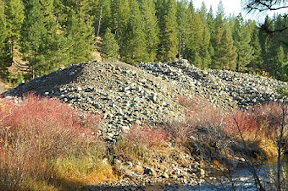If you've never spent time there, when you think of Oregon you might think of Portland (and it's constant political turmoil), Crater Lake, and the scenic coastline. And while the Oregon Coast and the Cascades are stunning, there's a lot more to Oregon, especially the overlooked Eastern half.
Oregon from Bend eastward is a combination of mountains and desert, forest and sagebrush. From the top of Steen's Mountain to the banks of the Snake River is nearly 8000' difference in elevation, and there's a lot of places in between. On our journey, our first stop eastward was the little town of John Day.
We've stopped here before and enjoyed our visits. There's a small, tree-shaded RV park next to the fairgrounds on the bank of the John Day River. It's a great place to stay while exploring the area.
Located at the base of the Strawberry Mountains, John Day was settled in the early 1860s as a mining town. In 1880 the official population was 280, but this number didn't include the estimated 1000 Chinese, all men, who worked as miners. Today the Chinese population is gone; the population is around 1500 and slowly decreasing.
We visited friends Robin and Donna who were volunteering as camp hosts high in the mountains at Magone Lake, drove the backroads of the Strawberry Mountains, and visited the interesting Kam Wah Chung Museum.
The Kam Wah Chung and Company ("Golden Flower of Prosperity") was a Chinese-owned grocery, dry goods store, and clinic, built in 1866 to serve the large Chinese population. It also functioned as a temple and joss house, unofficial post office, library, business and interpretive center, contract labor pool, social club, dormitory, and apothecary shop. One of the partners, Ing Hay was a "herbalist" who became known as "Doc Hay" and continued living in Kam Wah Chung until his death in 1955. He became the primary medical provider to many in the town, and was a popular member of the community.Because the original building was closed due to COVID, the visitor center staff had developed a "virtual" tour. We sat in front of a large screen while the host took us through each room, examined each shelf and item, and explained what we were seeing. The display was amazing, and as the host explained, the virtual tour allowed visitors to see far more than a physical visit.
From John Day, we traveled east for a week's stay at the Mountain View RV Park in Baker City. With views of the Elkhorn Mountains to the west and the Wallowa Mountains to the east, Baker City is one of Oregon's most picturesque towns. Sitting on the historic Oregon Trail, the town's main street reflects it's heritage as a major stop for thousands of travelers.
Baker City was a place where we could comfortably stay and use it as a base to explore the area. Our first visit was to the Sumpter Dredge, about 30 miles into the mountains. We've seen dredges before, and it always amazes us that these huge machines could move up a stream-sized river while excavating for gold. The dredge is huge - the boom alone has 72 one-ton buckets!
The dredge was basically a big sluice box and only needed three men to operate it; however, another 17 were needed for support (maintenance, admin, etc.). Although the dredge made $4.5 million during it's lifetime, it lost money and was shut down in 1954. The interior was immense with all kinds of motors, belts, pulleys, and chutes going in all directions. I have no idea how it all worked, but it must have been noisy!








